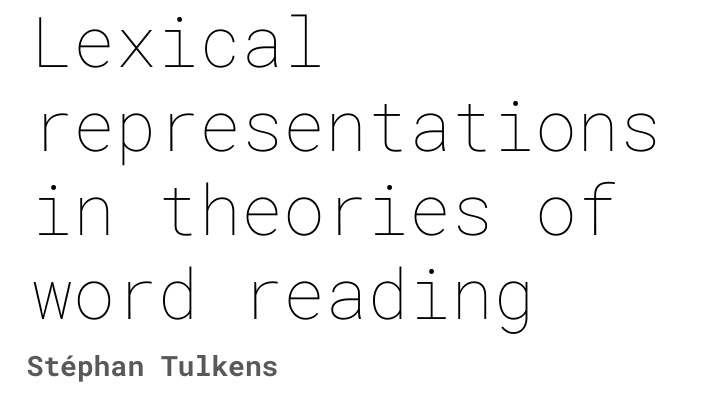



Lexical representations in theories of word reading Stéphan Tulkens
Overview Color legend 1. Word reading a. Introduction ENGLISH ● b. Common sense definition DUTCH ● 2. The dictionary metaphor FRENCH ● a. The mental lexicon b. The naive reader 3. Why the dictionary metaphor is false a. Phonology b. Meaning 4. The BIA+ model
Word reading
Some effects Most word reading is studied through priming studies Words which are preceded with something related are read faster. Orthographic : Bear - Beer ● Phonological : Fine - Wine (Rhyme) ● Semantics : Chair - Couch ●
Some effects Also works across languages Orthographic : Poison - Poisson ● Phonological : Feats - Fiets (Homophony) ● Semantics : Desk - Bureau ● Cognates : Wolf - Wolf (Superfacilitation) ● The cognate effect is unique for bilinguals
Opposite effects Ambiguity causes inhibition: Room : English or Dutch? ● Lead : Verb or Noun? ● Spin : Animal or action? ●
Word reading Common sense definition: The translation of groups of letters into meaning.
Word reading Common sense definition: The translation of groups of letters into meaning. D+O+G -> Dog -> Animal, Four legs, Loud
The Dictionary Metaphor
Mental Lexicon “The mental lexicon is defined as a mental dictionary that contains information regarding a word's meaning, pronunciation, syntactic characteristics, and so on.” Words are looked up in the “dictionary”, which “releases” ● the information in the entry. The orthography is the “key”, all other information is ● part of the entry.
Mental Lexicon The mental lexicon is often used as a theoretical construct in psycholinguistic experiments Words are often described as being retrieved and stored. ● The orthography of the word is often implicitly construed ● as the key of a dictionary -> Primacy of Orthography The orthography of a word is the word ●
Computers and dictionaries The dictionary metaphor naturally leads to a computer metaphor, with a memory bank, and key-value pairs.
The naive reader In the naive reader, word reading is feed-forward computation
I took the lead
The naive reader The naive reader is a computational theory of mind (CTM) implementation of word reading It involves sequential processing between isolated ● modules It only involves feed-forward activation between modules ●
The naive reader Semantics, syntax, pragmatics don’t affect reading
The Dictionary metaphor Revisited
Phonology The way a word sounds influences its access. Homographs are read more slowly : Lead , Wind ● Homophones are easily confused : Their and There ● Cross-lingual evidence : Room and Roem ● Phonology plays a role in access ●
Solution Add phonology to the key of the dictionary
Solution By adding phonology to the key of the dictionary, we’re saying that both readings of lead are different words Phonology has been transferred from Entry to Key.
Semantics Similarly, semantics plays an important role in bilingual access. Wolf is read quickly for Dutch - English bilinguals ● Spin is read more slowly ● The difference between these words is their shared semantics.
Semantics These effects are too quick to be post-access. Furthermore, semantic expectancies directly influence word access, also for monolinguals (Elman, 2009)
Solution Add semantics to the key
Solution (?) If we add semantics to the key of the dictionary, what is left in the entry?
A Real example
Bia Plus A bilingual model of word reading (Dijkstra & Van Heuven, 2002) Contains separate representations for ● Orthography, Phonology, and Semantics. Representations inhibit and facilitate ● each other Glass and Grass look alike, so inhibit each ○ other Beat sounds like Neat , so seeing Beat causes ○ activation of Neat
BIA Plus
Representations Example: O -> Room P -> /rum/ : /rom/ S -> Space : Cooking So, the key to the representation is Room-/rum/-Space for English, Room-/rom/-Cooking
Representations However: authors maintain separate representations for languages -> Language is part of the key O -> Room-en : Room-nl P -> /rum/ : /rom/ S -> Space : Substance for cooking Keys become: Room-en-/rum/-Space and Room-nl-/rom/-Cooking According to authors: no inhibition without 2 orthographic representations.
Homographs If Room needs two separate representations to achieve inhibition, then what about lead? O -> Lead-en P -> /led/ : /lid/ S -> ... The observed inhibition for monolingual homographs is very similar to the one for bilingual homographs.
Homographs Two options: 1. Admit that phonology provides enough information a. Implies language no longer needed in the key 2. Do not account for interlingual evidence a. Leads to a weak theory Similar arguments can be made for spin , but with extensions to semantics. Monolinguals can differentiate between bank , so how does ● spin differ?
The take-away Once one assumes the existence of representations with a static structure, problems arise in defining the difference between the key of a word and its content . Even if the problem of the key-content distinction is removed, we saw that a real model of word reading uses a definition of word related primarily based on orthography
Recommend
More recommend